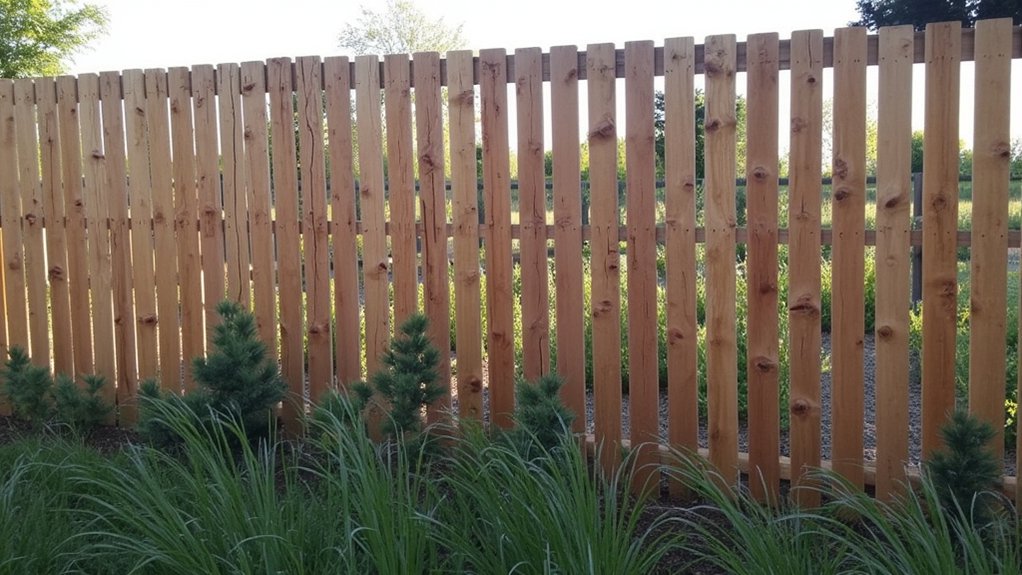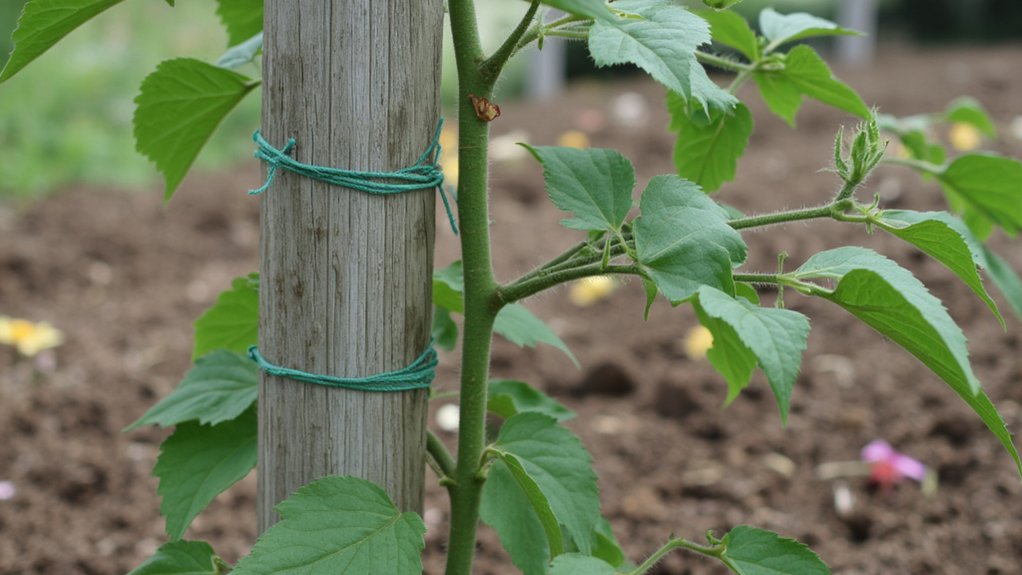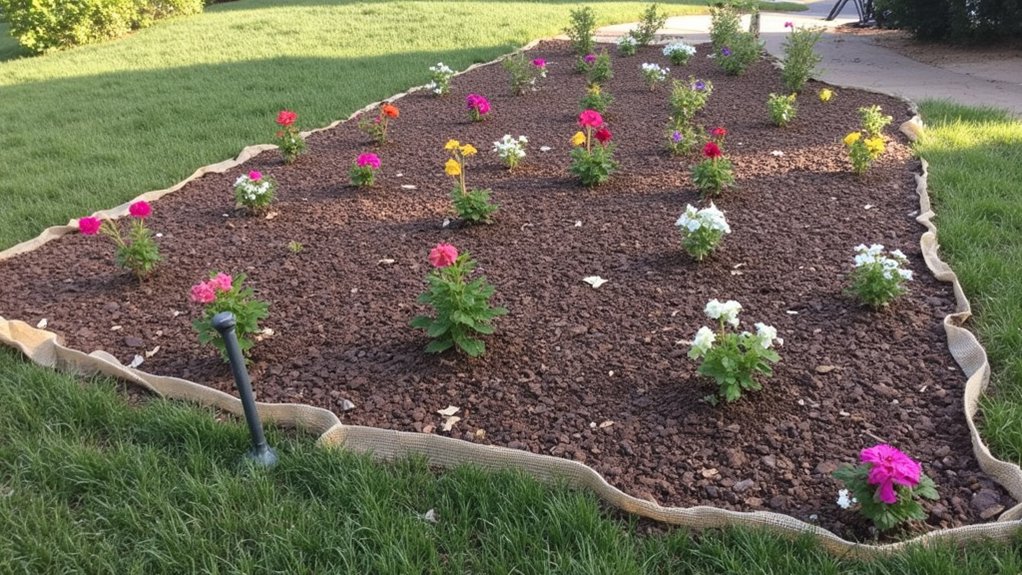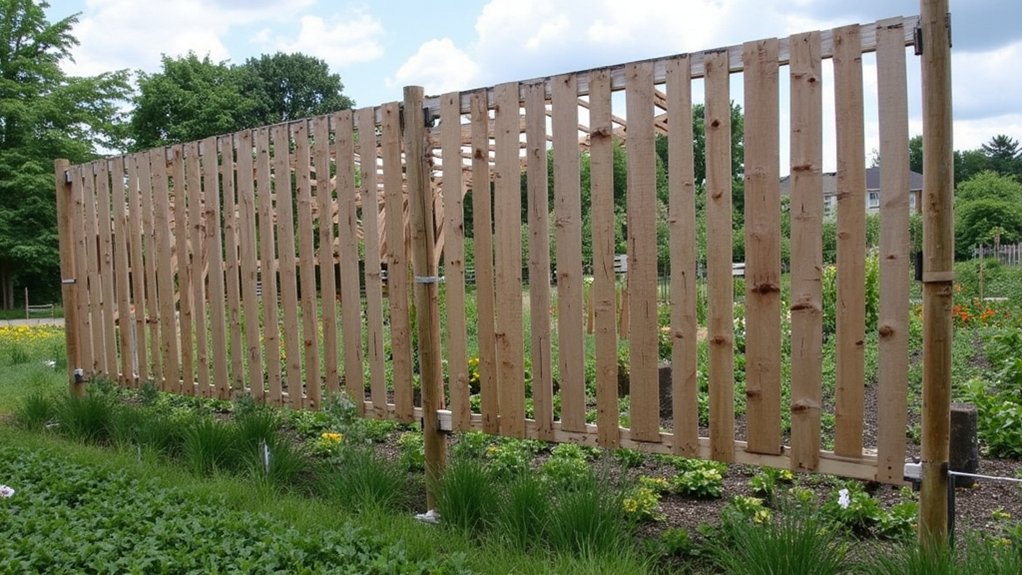Think of your garden as a fortress, ready to battle fierce winds. You’ve gotta shield your plants and trees from gusts that can snap branches or uproot tender shoots. Start by placing taller, sturdy plants—think 6-foot sunflowers or thick evergreens—on the windward side as natural barriers. Curious about building tougher defenses with minimal effort? Stick around for practical tricks to keep your green space standing strong.
Contents
Strong Windbreaks

While strong winds can wreak havoc on your garden, setting up solid windbreaks is a game-changer. You’ve gotta protect those delicate plants, and a good barrier does just that. Let’s get started with something sturdy.
First, pick a spot 10-15 feet upwind from your garden beds. Build a windbreak using dense materials like wooden panels or thick shrubs. Make sure it’s at least 6 feet tall, enough to block gusts effectively.
Next, secure it firmly—stake wooden barriers deep, about 2 feet into the ground, to avoid toppling. If you’re planting shrubs, space them 3 feet apart for a tight hedge. Check them monthly for stability, especially after storms. With this setup, you’re giving your plants a fighting chance against the wind.
Sturdy Mesh Barriers

Hey there, let’s talk about sturdy mesh barriers to shield your garden from those pesky winds. These barriers, often made of durable polyethylene, can cut wind speed considerably. You’ll find them in various heights, like 4 to 6 feet, perfect for most gardens.
Start by measuring your garden’s perimeter, ensuring you’ve got enough mesh to cover vulnerable spots. Secure the mesh to sturdy posts, spacing them every 5 feet, using zip ties or wire for a tight fit. This setup, if done right, can last several seasons with minimal upkeep.
Check the mesh weekly for tears or loose sections, especially after storms. Fix small issues pronto by patching with extra mesh. This’ll keep your plants safe without much hassle.
Strategic Plant Placement

As you plan your garden, consider strategic plant placement to combat wind damage effectively. Think about positioning taller plants, like trees or shrubs, on the windward side. They’ll act as natural barriers, slowing down gusts before they hit delicate blooms.
Now, place smaller, fragile plants—like young flowers or herbs—in sheltered spots, ideally behind those taller guardians or near walls. Aim for a buffer zone of at least 3-5 feet from the wind’s direct path. This setup minimizes stress on tender stems.
Lastly, group plants with similar wind tolerance together. Check your local wind patterns, maybe noting stronger breezes in late afternoons, and adjust accordingly. With a bit of planning, you’re setting up a garden that’ll stand strong against the breeze.
Reinforced Support Structures

Before the next storm rolls in, let’s talk about setting up reinforced support structures for your plants. You’ve gotta protect those tall or delicate ones from snapping. Start by identifying plants over 3 feet tall, as they’re most at risk.
Grab sturdy stakes, like 2×2-inch wooden posts or metal rods, and drive them 12-18 inches into the ground near the plant base. Use soft ties, such as garden twine, to secure the stems, leaving a little slack for movement. Don’t cinch too tight, or you’ll damage the bark.
Check these supports every 2-3 months, adjusting as plants grow. If a stake wobbles, hammer it deeper. This setup’s a game-changer for keeping your garden standing strong against fierce winds.
Flexible Plant Varieties

While you’re setting up those sturdy supports, don’t overlook the power of choosing flexible plant varieties for your garden. Some plants, like bamboo or certain grasses, naturally bend in strong winds without snapping. They’ve got that built-in resilience, so you won’t stress over broken stems after a storm.
Start by researching species suited to your area’s wind patterns—think native plants like switchgrass or feather reed grass, which can sway up to 45 degrees without damage. Check local nurseries for these options, and plant them in spring for best root establishment. Space them at least 18 inches apart to allow movement.
You’ll save time on repairs with these choices. Just pick wisely, and watch your garden stand tall, even in gusty weather.
Regular Pruning Techniques

Hey, let’s shift gears from picking the right plants to shaping them with regular pruning techniques. You’ve gotta keep your trees and shrubs in check to prevent wind damage. Overgrown branches can snap easily, so don’t let ‘em get out of hand.
Start by grabbing sharp, clean pruning shears or loppers, and inspect your plants every 2-3 months. Look for dead, damaged, or crossing branches—cut ‘em off at a 45-degree angle, about ¼ inch above a healthy bud. This promotes strong growth and reduces wind resistance.
Focus on thinning dense canopies, too. Remove inner branches to let air flow through, cutting no more than 25% of the plant at once. Trust me, this’ll keep things sturdy when gusts hit hard.
Protective Ground Coverings

Now that we’ve tackled pruning, let’s explore using protective ground coverings to shield your plants from wind. These coverings act as a barrier, reducing wind impact on delicate roots and soil. You’ve gotta try this to keep your garden safe!
Start by choosing materials like mulch, straw, or burlap, which work best for most plants. Spread a 2- to 3-inch layer of organic mulch around the base, keeping it 2 inches from stems to avoid rot. This insulates the soil, holding moisture and preventing erosion.
Next, secure heavier coverings like burlap with stakes or rocks if winds are strong. Check them every week, adjusting as needed to guarantee they stay in place. Trust me, this small effort pays off big time for your plants!
Seasonal Wind Forecasts

As we shift gears to seasonal wind forecasts, let’s get you prepared for what’s ahead. You’ve gotta know when strong winds are coming, so check local weather services regularly. They often predict gusts up to 30 mph or more, especially during fall and spring.
Start by visiting websites like the National Weather Service for monthly outlooks. These forecasts, updated weekly, can warn you about high-wind periods at least 7-10 days in advance. Jot down key dates on your calendar to stay ahead.
Also, download a weather app for real-time alerts on your phone. Set notifications for wind speeds over 25 mph, so you’re never caught off guard. With this info, you’ll plan better and protect your plants effectively.
Emergency Wind Shields

While you’re tracking those seasonal wind forecasts, let’s plunge into setting up emergency wind shields for your plants. Don’t wait for a storm to hit; act now. You can protect your garden with quick, sturdy barriers.
First, grab some heavy-duty materials like burlap or plastic sheeting, about 4 feet wide. Stake them into the ground using metal or wooden posts, spacing them every 3 feet for stability. Make sure the shield stands at least 2 feet taller than your tallest plant, blocking those harsh gusts.
Check your setup within 24 hours of a wind warning, tightening any loose stakes. Keep extra materials handy for sudden repairs. With these steps, you’re giving your plants a fighting chance against unexpected winds.
Elevated Wind Deflectors

Before you tackle another layer of plant protection, let’s plunge into building elevated wind deflectors for your garden. These structures, raised above ground, redirect harsh winds over your plants. You’ll save your tender greens from getting battered.
Start by grabbing sturdy materials, like 4-foot-tall wooden panels or metal sheets. Secure them on 6-foot posts, hammered 2 feet into the soil, spacing posts 5 feet apart. Face the deflector toward the prevailing wind direction, ensuring it’s angled slightly, about 10 degrees, to lift gusts upward.
Check your setup after storms; tighten bolts if needed. It takes just a weekend to build, roughly 4-6 hours, depending on your plot size. Trust me, your garden’ll thank you with healthier growth, even if silently!
